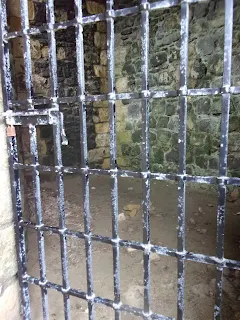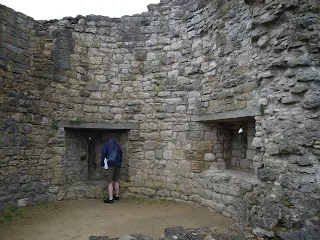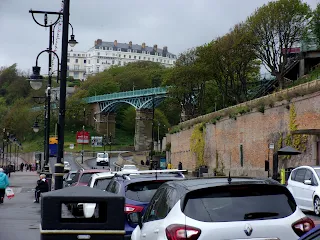In typical Bank Holiday fashion, it decided to tip it down the day we went to Scarborough. But I simply put on my hat and got on with it. I've been to Scarborough only once before, as a kid, but I got a strong sense of déjà vu on entering the town.
We climbed upwards towards Scarborough Castle, stopping at St Mary's Church. The church was built in the 12th century, rebuilt in the 17th century and restored in the mid 19th century.
The church has a section of graveyard over the road, and I wouldn't mind living in this little turret...
Anne Brontë (1820-1849) was one of the famous literary sisters and author of Agnes Grey (1847) and The Tenant of Wildfell Hall (1848). She died in Scarborough and is buried in the graveyard of St Mary's. That latter novel of hers is one of my favourites of all time.
...But I believe it's part of this building, which is a guest house...
The headstone is now almost illegible and contained an error anyway; stating that Anne was 28 when she died, when she was, in fact, 29.
The Brontë Society added the flat plaque correcting the error in 2011.

Anne visited Scarborough for her health, and stayed in lodgings on the spot that is now the Grand Hotel. It was decided that she should be buried here, rather than transported back to her home in Haworth.

St Mary's chancel was rebuilt c. 1450 and subsequently destroyed in the Civil War, when the church served as a parliamentary base for the firing of cannons at the castle. The castle reciprocated, and here you can see the ruins of the east side standing sentinel.
The view down over Scarborough Bay was pretty impressive but it's a shame the day wasn't- here you can see where raindrops have tainted my camera.
Entering Scarborough Castle via the barbican (or outer fortification) and gate. The first reference to a barbican being on this site occurred in 1175.
Taken from the other side of the rugged castle, and the exhibition is held in the Master Gunner's House which you can see peeking out to the right.
Inside the exhibition, and here are some Scarborough excavations...
Pottery...
This chunky lump is a section of 15th century cross-shaft (a cross-shaft is a masonry wall that divides the keep in two). This shows Christ flanked by the Virgin Mary and St John.
Cannonballs...
Pottery, horseshoes and I especially loved the tobacco pipes to the right.
Pottery, and the face jug (the black object just centre right) was my favourite piece.
Heavy cannons were mounted at the castle, and the type and number required varied over time.
Staring into a basement of strong foundations. The basement was used as a repository for latrine chutes.
Inner bailey...
North Bay, and there once used to be a pier here, but it was destroyed in a storm in 1905.
The great tower was built between 1159 and 1169, by Henry II (r. 1154-89), after he demanded return of a royal castle which had already been established here in the 1130s. He then began developing a town beyond the walls of the castle.
Here you can see the entrance to the modern viewing platform, which is set just below the medieval first floor level.
Looking down to the basement, and Scarborough takes its name from Viking raider Thorgils Skarthi, who is alleged to have founded Skarõaborg in 966 AD. Could this be Icelandic folklore? There is no archaeological evidence to support this claim.
View down to the Master Gunner's House. A Master Gunner was an experienced or veteran artilleryman who maintained every aspect of gun equipment.
View down to the inner bailey, and a bailey is a courtyard surrounding the moat with a defensive wall to keep out unwelcome company.
The castle would have split in two during the 1644 Civil War raid, when intense bombardment caused half of the building to collapse.
In the fourth century, before there was a castle, the Romans built a fortified signal station here; this diamond-shaped promontory lending itself perfectly to such a use.
The North Bay, taken from the contemporary viewing platform.
Gazing up the ruined castle's thick walls, and Scarborough now has a population of roughly 62,000 people...
Fireplace...
Staring up into its chimney...
Staring up at the floors- there was a basement, first floor, second floor and a top storey; the latter probably filled by the roof structure.
The modern stairs are less steeply pitched than the originals. No documents reveal exactly how the castle tower was used in the 12th century.
All that remains of the King's Hall, which was a public chamber where the whole household ate.
Looking over to King John's chamber block, which was constructed between 1210 and 1211.
Sometimes a photograph comes out just right, and this is one of those times...😀
I loved the fact that from the viewing platform you can see both North Bay...
...And South Bay, featuring Scarborough Harbour...
The well...
View down into hell...
Moat and "motte," which is the Anglo-French spelling. It means mound, hill or bank.
This headland site has been intermittently occupied for more than 3,000 years...
The wall that overlooks the town was built between 1202 and 1212. There was once a tower on the far corner called the Cockhyll Tower. It was still in use in 1666, when the castle served as a prison, but was severely damaged in the 1730s due to a cliff collapse.
I think the metal slats merely serve to hold this section under the arch together. The castle suffered bombardments during World Wars I and II.
King John's chamber block and, whilst it was common for grand establishments to have a separate kitchen, hall and chamber block, it's unclear why King John thought to sleep here, as the castle had a great tower at his disposal.

All that remains today is the basement.
This arch led to a grille...
I did overhear a guide say that this part was possibly used as a wine cellar...
The building would originally have been two storey, with one large and one small room on each level, with a tower providing an extra room opening off each floor.
The lost above floor would have been the principal storey and was accessible by separate external stairs. Both rooms were warmed by fires.
The building once rose above the height of the walls...
...But documentary evidence shows that by 1538 the building was in decay...
This lodging was converted into barracks after 1745, but these were demolished in 1914 after German shelling caused considerable damage.
It looks like these steps have been fenced off as they're unsafe to climb...
Nature always wins, and here pretty flowers fight through the cracks to form a natural rockery.💛
The castle was built by successive medieval kings over two centuries.
These curtain wall towers were hollow, to allow for the insertion of floors.
The castle was largely destroyed when Parliamentarians besieged it twice during the English Civil War.
I think these viewing slits have been filled in to stabilise them.
Another curtain wall tower.
New life was breathed into the castle as it was used for defence against the Jacobites, Napoleon and then finally the Kaiser.
View back along the curtain wall, which was built by King John between 1202 and 1212. It's presumed that this replaced an an earlier line of defences.
Steps leading down to the sally port...
This leads to the site of the South Steel Battery, but erosion has made it inaccessible...
Gaping back up the stairs, and the purpose of a sally port is to defer and defend unwanted entry or exit...
This is the site of the Roman Signal Station, built around A.D. 370.
Memorial plaque to Christians interred during the Middle Ages.
Standing by the signal station site...
Well...
I wouldn't want to fall down there!
St Mary's Chapel dates back to A.D. 1000...
Gazing through the bars and it was rebuilt in the 12th century...
...And again in the 14th century.
Our last impressive on-site view as we made our way to the exit.
I almost missed this model of the castle complex, near the Master Gunner's House...
Walking down the steps beside St Mary's Church, down to the Old Town and the seaside...
We walked down West Pier and this is Scarborough Pier Lighthouse, which sits just over the water. It dates back to 1806 but had to be rebuilt in 1914 after being bombarded by the Germans.
To the right of this photo is Luna Park, which is a funfair.
Should we call this Scarborough Fair? Probably not! Scarborough Fair dates back to the Middle Ages- maybe as far back as 1155- when tradesmen came from all over England, and also from the Baltic states, the Byzantine and Ottoman Empires and Norway and Denmark to trade their wares in a huge 45 day affair which took place across the town. The fair ended in 1788, but nowadays celebrations take place every September to mark the event.
The fair is the subject of the traditional ballad, "Scarborough Fair," which has possibly been sung since 1670.
Looking over South Bay Beach seeing Cliff Bridge, the Grand Hotel and Scarborough Big Wheel which is a 32 m high observation wheel.
The Grand Hotel was built in 1863 and previous residents include Winston Churchill, Edward VIII when he was Prince of Wales and the Beatles.
The Central Tramway is a funicular- or cliff railway- built in 1881. There were once five cliff lifts in Scarborough and there are now only two; the other one being the 1875 Scarborough Spa Cliff Lift, which sits next to that building.
Cliff Bridge used to be known as the Spa Bridge, and dates back to 1827. Seagulls like to nest underneath the iron spans. We were lucky- none of them decided to have a dump on us!
😁😁😁
Around 1628 Thomasin Farrer, the wife of one of Scarborough's most prominent citizens, John Farrer, found natural spring water bubbling out from underneath the cliffs. The waters were bitter but were said to cure various ailments. As thousands flocked to the town to try its medicinal properties for themselves, Scarborough began to gain popularity as a resort.
This photo was taken whilst standing on the beach just below the stairs. You can see the well set into the wall.
You can see where the water stained the bricks this russet colour. Today this is the only remaining evidence of the spa water, which was deemed unfit for human consumption in the late 1960s.
Looking back up a very wet South Bay Beach...
We climbed the stairs up and over Scarborough Spa, which is a venue for conference, exhibitions, events and live music. The building showcases the architecture of the 1880s, and major restoration was carried out in the early 1980s. It houses a Grand Hall, the Spa Theatre, the Ocean Room, the Promenade Lounge and the Sun Court, which is utilised for outdoor music performances.
The Sun Court makes for a striking backdrop, and you can see the cliffs of Filey Brigg in the distance.
The Sun Court has featured in the musical film Little Voice (1998) and the short film Dancing Queen (1993), which starred Rik Mayall and Helena Bonham Carter. But I remember it most from the supernatural series Remember Me (2014), starring Michael Palin.
By this time the rain was kicking up a merry dance and I needed to rest, eat, and didn't feel inclined to play any more, so we decided to call it quits.
Rain falling over this pond which sits under Valley Bridge Road, and even the ducks had decided to give up on the day!
The Rotunda Museum: Museum of Coastal Heritage and Geology, with the Esplanade Hotel and the Grand Hotel in the background. We passed this as we went to find our bus.
Scarborough, I have plans to return next year, explore the Spa in more detail and maybe have a cream tea on/overlooking (depending on the weather) the Sun Court.
Until then,
TTFN
The Miss Elaineous
XXXXXXXXXXXXXXXXXXXXXXXXXXXXXXXX
XXXXX
X














































































.jpg)
.jpg)
No comments:
Post a Comment